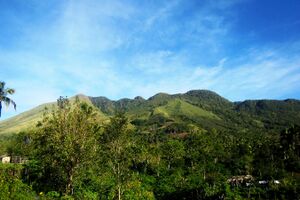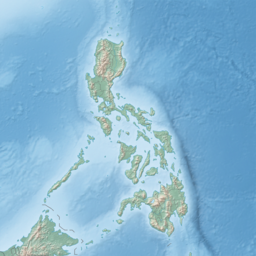Earth:Mount San Cristobal
From HandWiki
Short description: Volcano in the Philippines
| Mount San Cristobal | |
|---|---|
 | |
| Highest point | |
| Elevation | 1,470 m (4,820 ft) [1] |
| Listing | Potentially active[2] |
| Coordinates | [ ⚑ ] : 14°03′52″N 121°25′36″E / 14.06443°N 121.42680°E |
| Geography | |
| Location | Luzon |
| Country | Philippines |
| Region | Calabarzon |
| Provinces |
|
| Municipalities |
|
| Geology | |
| Mountain type | Stratovolcano |
| Volcanic arc/belt | Macolod Corridor |
| Last eruption | Unknown |
| Climbing | |
| Easiest route | from Dolores, Quezon |
| Lua error in Module:Mapframe at line 384: attempt to perform arithmetic on local 'lat_d' (a nil value). | |
| Part of a series on the |
| Paranormal |
|---|
Mount San Cristobal is a potentially active stratovolcano at the boundary of the provinces of Laguna and Quezon on the island of Luzon, Philippines . The mountain rises to an elevation of 1,470 m (4,820 ft) above mean sea level[1] and is one of the volcanic features of Macolod Corridor.[3]
Mount San Cristobal is considered the Devil's Mountain in Filipino folklore. It is the alter-ego of the Holy Mountain,[1] Mount Banahaw, and is part of Mounts Banahaw–San Cristobal Protected Landscape, covering 10,901 hectares (26,940 acres) of land.
The mountain is bordered by San Pablo in the province of Laguna at its northern slope and Dolores in the province of Quezon at its southern slope.
See also
- List of mountains in the Philippines
- List of national parks of the Philippines
References
- ↑ 1.0 1.1 1.2 "Mt. Cristobal (1,470+)". 23 September 2007. http://www.pinoymountaineer.com/2007/09/mt-cristobal-1470.html. Retrieved 5 February 2015.
- ↑ "Potentially Active". 30 July 2008. http://www.phivolcs.dost.gov.ph/index.php?option=com_content&view=article&id=60:potentially-active&catid=55&Itemid=115. Retrieved 24 March 2016.
- ↑ Tectonophysics. Amsterdam: Elsevier Science Publishers. 1990. p. 266.
External links
 |



